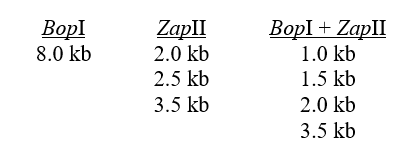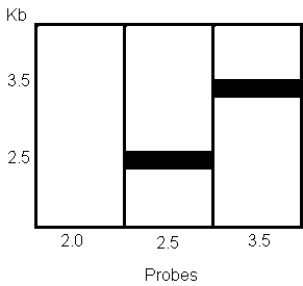A chimeric plasmid contains vector DNA ligated to a fragment of chromosomal mouse DNA that is suspected of containing the obese gene.As a first step,a restriction map of the DNA clone was constructed.The DNA was digested with two restriction enzymes,BopI and ZapII,with the following results:
a)From these data,answer the following questions.
(1)How large is the entire DNA clone?
(2)Is the clone linear or circular?
(3)Draw a restriction map consistent with these data.Include all BopI and ZapII sites and the physical distances between them.
b)To better identify the location of the mouse chromosomal DNA on this chimeric plasmid,mouse genomic DNA was digested with ZapII,run on a gel,and analyzed using the Southern blot technique.The Southern blot was probed with radiolabeled Zap II DNA fragments from the plasmid DNA.Three lanes each containing the same amount of Zap II-digested chromosomal DNA were each probed with a different fragment from the plasmid.Autoradiograms showed the following: What is the maximum amount of mouse DNA present in the clone? Why didn't the 2.0-kb ZapII fragment hybridize to the mouse DNA? 
Correct Answer:
Verified
1)8.0 kb
2)A circular plasmid is the ...
View Answer
Unlock this answer now
Get Access to more Verified Answers free of charge
Q45: The restriction enzyme ClaI recognizes the
Q46: When ligating pieces of DNA into a
Q47: In a certain community,a mutant allele
Q48: The autoradiogram shown was generated by the
Q49: A linear molecule of DNA 9 kb
Q50: A DNA fragment produced by the
Q51: A certain animal virus contains a circular
Q52: Use the following data to generate a
Q54: The drawing below depicts a restriction map
Q55: A purified DNA preparation of a certain
Unlock this Answer For Free Now!
View this answer and more for free by performing one of the following actions

Scan the QR code to install the App and get 2 free unlocks

Unlock quizzes for free by uploading documents